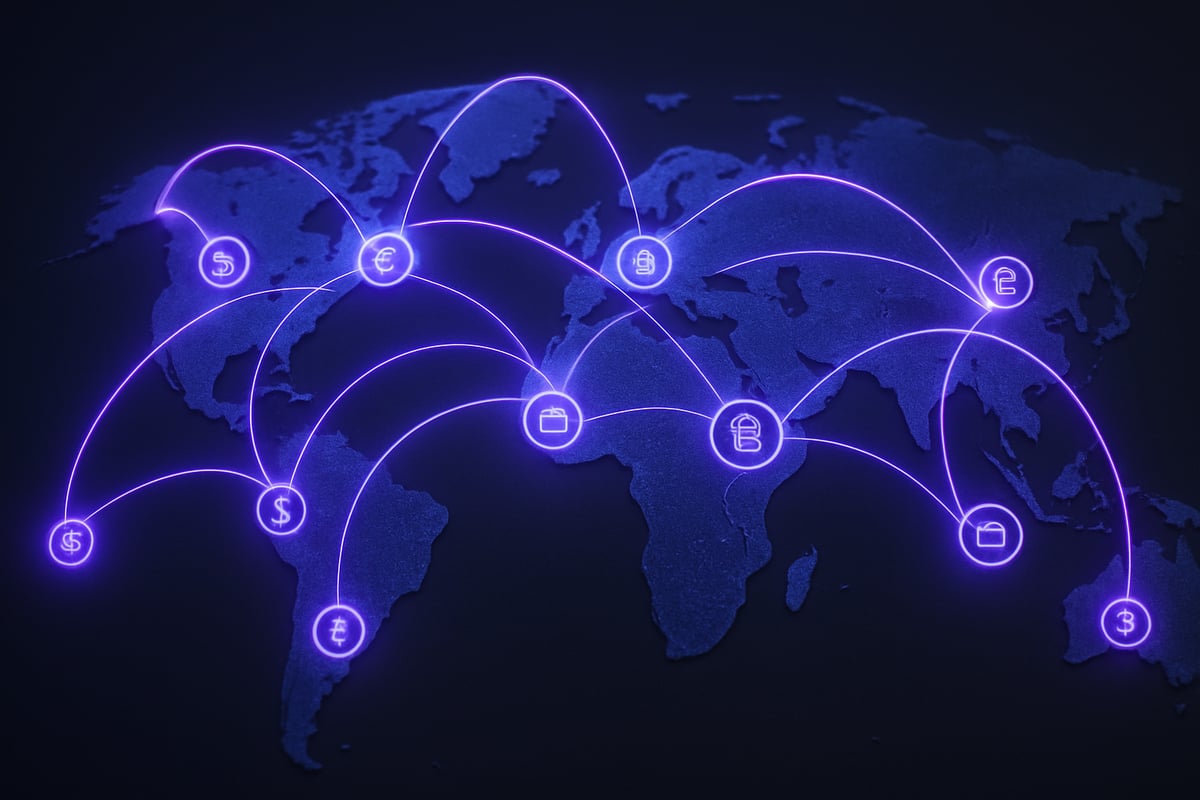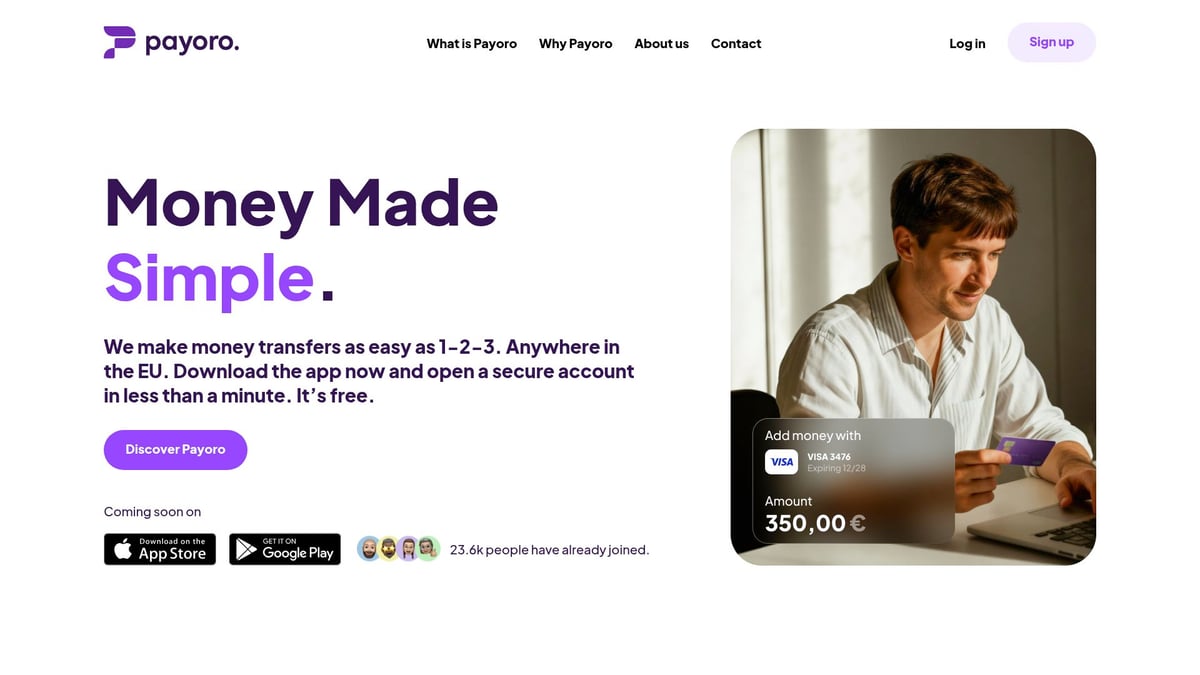The Essential Payment Cross Border Guide for 2025
Master payment cross border with our 2025 guide Cover regulatory updates, new methods, tech trends, and risk management for seamless global transactions
Published November 20, 2025 — 18 minutes read — Fintech Guides
Written by François Savard
Cross-border payments are rapidly evolving in 2025, bringing new complexities for businesses and individuals worldwide. As global commerce expands, the demand for efficient and secure payment cross border solutions has never been higher. Those who master these strategies gain significant advantages, including cost savings, broader global reach, and a competitive edge in the marketplace.
This essential guide covers everything you need to know, from regulatory shifts and innovative payment methods to technology trends, risk management, and practical steps for making seamless international transactions. Get ready to navigate the future of payment cross border with confidence.
Understanding the Cross-Border Payment Landscape in 2025
The landscape for payment cross border transactions is transforming rapidly in 2025. Businesses and individuals face new complexities, from evolving technology to shifting regulations. Understanding these changes is crucial for anyone looking to optimize their payment cross border strategy and maintain a competitive edge.

Key Trends Shaping Cross-Border Payments
The surge in global e-commerce has led to unprecedented payment cross border volumes. Consumers and businesses expect faster, more convenient ways to transact worldwide. Digital wallets and alternative payment methods are gaining traction, especially in emerging markets.
Real-time payments are now the norm, with instant settlement options shaping expectations. Emerging markets in Asia and Latin America are driving new corridors, expanding opportunities for payment cross border growth. According to Global cross-border payment flows projected to surpass $250 trillion in 2025, the sheer scale of these flows highlights the sector’s significance this year.
Regulatory Developments and Compliance
Regulations play a pivotal role in shaping payment cross border operations. New frameworks like PSD2, AMLD6, and FATF guidelines are setting higher standards for transparency and security. The European Union is pushing for instant payments and greater clarity, impacting both providers and users.
KYC and AML compliance are now mandatory for most payment cross border transactions. Businesses must stay agile to keep pace with frequent regulatory updates, or risk facing penalties and operational delays. Proactive compliance management is a non-negotiable part of cross-border payment strategy.
Payment Methods: Traditional vs. Modern Solutions
Choosing the right payment cross border method is critical for speed and cost. Traditional systems like SWIFT, SEPA, and correspondent banking remain popular but can be slow and costly. Modern fintech solutions and blockchain-based options are transforming the space.
| Method | Speed | Cost | Transparency |
|---|---|---|---|
| SWIFT/SEPA | Hours-Days | Medium | Moderate |
| Fintech/Blockchain | Minutes | Low | High |
Notably, SWIFT GPI now processes 40% of payment cross border transactions within 30 minutes, narrowing the gap with fintech upstarts.
Cost Structures and Hidden Fees
Understanding payment cross border costs is essential for accurate budgeting. Providers use various fee models:
- Flat fees per transaction
- Percentage-based charges
- FX margin on currency conversion
Hidden costs like intermediary fees, conversion losses, and unexpected delays can add up. For SMEs, average payment cross border transaction fees range from 1% to 5%. Always assess the full fee structure to avoid unpleasant surprises.
Challenges Facing Businesses and Individuals
Payment cross border activities bring unique challenges. Currency volatility can erode profits, while fluctuating exchange rates introduce risk. Navigating regulatory complexity and compliance requirements can be time-consuming.
Security threats, fraud, and payment delays remain significant concerns. Payment reconciliation and transparency issues can disrupt cash flow and strain business relationships. Staying informed and adopting robust risk management practices is essential for success in the payment cross border landscape.
Step-by-Step Guide: How to Make Seamless Cross-Border Payments in 2025
Navigating the payment cross border process in 2025 requires a strategic approach. With evolving technology and regulations, businesses and individuals must adapt to ensure efficiency, compliance, and cost savings. This guide will walk you through each essential step for seamless payment cross border transactions in today’s dynamic global environment.

Step 1: Assess Your Payment Needs and Destinations
Begin by evaluating your payment cross border requirements. Identify the volume and frequency of your international transactions, as well as the countries or regions involved.
Consider local currency needs and recipient payout preferences. For example, a business expanding into Asia-Pacific may encounter different regulatory and currency challenges compared to those entering EU markets.
Ask yourself:
- What currencies will you send and receive?
- Are your recipients individuals, suppliers, or partners?
- How often will you process cross-border payments?
A clear understanding of your payment cross border needs will shape your provider selection and risk management strategy.
Step 2: Choose the Right Payment Provider
Selecting a reliable payment cross border provider is crucial. Evaluate providers based on speed, cost, security, global coverage, and customer support.
Compare traditional banks with fintech platforms. For instance, solutions like Wise, PayPal, and Seamless cross-border payments platform offer competitive rates, instant transfers, and multi-currency support for EU transactions.
Key criteria to assess:
- Transaction fees and FX rates
- Supported countries and currencies
- Integration options (API, digital platforms)
- Regulatory credentials and customer reviews
Choosing the right partner ensures your payment cross border process is efficient and secure.
Step 3: Ensure Regulatory Compliance and Documentation
Compliance is a non-negotiable aspect of payment cross border activities. Prepare the necessary documentation, including Know Your Customer (KYC), Anti-Money Laundering (AML) records, and business verification documents.
Understand both local and international compliance obligations. Streamline onboarding by organizing documents in advance and using providers with automated compliance checks.
Checklist for compliance:
- Valid identification and business registration
- Proof of address and tax documents
- Ongoing transaction monitoring
Proper documentation protects your payment cross border transactions from regulatory risks and delays.
Step 4: Initiate and Track Your Payment
Once compliance is in place, use digital platforms or APIs to initiate your payment cross border transactions. Modern platforms provide user-friendly dashboards and real-time tracking features.
Benefits of digital initiation:
- Faster processing times
- Automated notifications
- Transparent transaction statuses
For example, API-driven platforms enable instant updates, allowing you and your recipients to monitor each payment cross border journey from initiation to settlement.
Step 5: Manage Currency Exchange and Settlement
Currency conversion is a critical part of payment cross border operations. Evaluate your options for exchange rates, whether through your provider’s rates or open market rates.
To optimize costs and minimize FX risk:
- Compare provider and market rates
- Consider locking in rates for large or recurring payments
- Explore multi-currency accounts for holding and converting funds
Effective management of exchange and settlement ensures your payment cross border transactions remain predictable and cost-effective.
Step 6: Reconcile and Report Transactions
The final step in the payment cross border process is reconciliation and reporting. Use automated tools that integrate with your accounting software to match payments, generate audit trails, and produce compliance reports.
Key practices:
- Automate reconciliation to reduce manual errors
- Maintain accurate records for tax and regulatory purposes
- Schedule regular audits and reviews
By implementing robust reconciliation and reporting, you can ensure transparency and accountability for every payment cross border transaction.
Technology Innovations Transforming Cross-Border Payments
The payment cross border landscape in 2025 is being reshaped by rapid technological advancements. Businesses and individuals now benefit from faster, smarter, and more secure ways to move money internationally. From blockchain to AI, each innovation brings new possibilities and challenges. Let us explore these key technologies and their impact on payment cross border transactions.

The Role of Blockchain and Cryptocurrencies
Blockchain technology is transforming payment cross border transactions by streamlining settlements and reducing costs. With its decentralized ledger, blockchain enables instant verification, eliminating lengthy intermediaries. Businesses can use stablecoins, central bank digital currencies (CBDCs), and tokenized payments for efficient transfers.
Key innovations include:
- Faster settlement times and lower fees
- Increased transparency and traceability
- Integration of stablecoins for price stability
RippleNet, for example, is widely adopted by global banks, providing reliable payment cross border solutions. As adoption grows, blockchain is likely to become central to international payments, offering speed and security unmatched by legacy systems.
API Integration and Open Banking
API-driven solutions are revolutionizing payment cross border processes for businesses. APIs allow seamless connections between payment providers, ERPs, e-commerce platforms, and payroll systems. This integration enables faster payment initiation, real-time tracking, and automated reconciliation.
Open Banking standards are driving payment automation and improving user experiences. A recent example is the DBS and Ant International expand partnership to boost cross-border payments, which highlights how leading banks use APIs to deliver instant payment cross border services across Asia.
Businesses choosing API-first platforms gain scalability and flexibility, ensuring that their payment cross border operations remain agile as markets evolve.
Artificial Intelligence and Machine Learning
Artificial intelligence is now at the core of payment cross border risk management and optimization. AI-powered systems detect fraud in real time, adapt to new threats, and reduce false positives. Machine learning models analyze transaction patterns, predicting anomalies before they disrupt business.
For payment cross border providers, the benefits include:
- Automated compliance checks
- Dynamic FX rate optimization
- Improved customer support with AI chatbots
A recent study showed machine learning models reducing false positives by 30 percent. By leveraging AI, businesses can secure their payment cross border transactions and streamline operations.
Mobile and Digital Wallets
Mobile-first solutions are now mainstream in payment cross border commerce. Digital wallets such as Alipay, Apple Pay, and Google Pay enable users to send and receive funds globally with a tap. These wallets support multiple currencies and offer instant notifications for every transaction.
For payment cross border transactions, mobile wallets deliver:
- High speed and convenience
- Enhanced security through biometric authentication
- Broad acceptance in both developed and emerging markets
In 2025, mobile wallets account for more than half of global e-commerce payments. Their integration with local payment rails ensures a smooth cross-border experience for both merchants and consumers.
Security and Data Protection Advances
With increased payment cross border activity, security and data protection are more important than ever. Advanced authentication methods such as biometrics and tokenization are now standard. Providers comply with GDPR, PSD2 SCA, and other global data privacy regulations to protect users.
Payment cross border platforms implement multi-factor authentication and encryption, reducing fraud rates significantly. For example, strong customer authentication has led to a measurable decline in unauthorized transactions.
Staying ahead in payment cross border security means adopting the latest technologies and maintaining continuous compliance with evolving standards.
Key Considerations for Businesses: Optimizing Cross-Border Payment Operations
Optimizing payment cross border processes is essential for businesses aiming to scale internationally in 2025. With the right strategies, companies can reduce costs, improve efficiency, and stay competitive. Each aspect of payment cross border operations, from payouts to reporting, requires careful attention to detail and the adoption of modern solutions.
Streamlining Payouts to Suppliers, Freelancers, and Partners
Efficient payment cross border payouts are crucial for maintaining strong business relationships. Mass payout solutions empower companies to send multiple payments in different currencies instantly. This is especially important for businesses managing a global workforce or diverse supplier base.
Case studies show that European tech companies have enhanced contractor satisfaction and loyalty by adopting instant and flexible payout options. Initiatives like the European Payments Alliance launches cross-border instant payments are driving new standards for speed and transparency, reducing friction across international corridors.
Key benefits include:
- Reduced payment delays
- Lower administrative overhead
- Enhanced partner trust and retention
Managing Multi-Currency Accounts and Treasury
Holding multiple currencies in dedicated accounts is a proven strategy for optimizing payment cross border transactions. This approach allows businesses to avoid unnecessary conversion fees and manage foreign exchange exposure more effectively.
Automated treasury tools help monitor balances, automate conversions, and provide real-time insights. For example, SMEs leveraging multi-currency accounts have reported significant savings on conversion fees and improved cash flow predictability.
Key considerations:
- Choose providers offering flexible multi-currency accounts
- Use hedging tools to minimize FX risk
- Monitor currency trends to optimize conversion timing
Ensuring High Acceptance Rates and Customer Satisfaction
Achieving high acceptance rates in payment cross border operations requires understanding local payment preferences and integrating the right payment rails. Failed transactions and chargebacks can erode customer trust and impact revenue.
Businesses can boost acceptance rates by offering preferred local payment methods, ensuring robust infrastructure, and continuously monitoring transaction data. For instance, companies with a resilient payment cross border setup have documented acceptance rates as high as 99 percent.
Strategies for success:
- Localize payment options for each market
- Invest in infrastructure that supports scalability
- Analyze and address reasons for failed payments
Integrating with Business Systems and APIs
Seamless integration of payment cross border platforms with ERP, CRM, and e-commerce systems streamlines operations and reduces manual effort. Unified dashboards and real-time reporting enhance visibility and control over international transactions.
API-driven solutions enable businesses to automate reconciliation, generate instant reports, and respond quickly to operational changes. Companies adopting API integration have reduced reconciliation times by up to 40 percent, freeing teams to focus on growth.
Integration best practices:
- Select platforms with robust API documentation
- Ensure compatibility with existing business tools
- Prioritize security and data privacy in all integrations
Navigating Taxation and Regulatory Reporting
Payment cross border activities are subject to complex tax and regulatory requirements, including VAT, GST, and local reporting obligations. Automated solutions simplify tax calculations, generate compliance reports, and reduce the risk of errors.
For digital businesses in the EU, the VAT One-Stop-Shop (OSS) system offers a streamlined approach to cross-border tax reporting. Staying updated on regulatory changes is essential for maintaining compliance and avoiding penalties.
Tips for compliance:
- Use software that updates in line with local tax laws
- Automate report generation for audits
- Consult with tax professionals for international operations
Payoro: Seamless and Secure Cross-Border Payments for the EU and Beyond
Payoro’s platform is designed for businesses and individuals seeking a secure and efficient payment cross border experience. Key features include instant money transfers, support for multiple currencies and crypto, and robust API integration.

Payoro ensures regulatory compliance, advanced security, and real-time 24/7 payouts. EU-based merchants benefit from frictionless onboarding, zero monthly fees, and the ability to expand globally with confidence. Payoro’s commitment to seamless payment cross border operations makes it a trusted partner for modern businesses.
Risk Management and Fraud Prevention in Cross-Border Payments
Navigating the payment cross border landscape in 2025 means facing increasingly sophisticated risks. Businesses and individuals must stay vigilant as threats evolve, especially with rising transaction volumes and complex global networks. Effective risk management is essential for secure, seamless international payments.
Common Risks in International Transactions
The payment cross border environment exposes organizations to various threats. Common risks include:
- Payment fraud, such as phishing and social engineering
- Cyberattacks targeting transaction data
- Regulatory non-compliance, leading to fines or sanctions
- Delays from banking errors or regulatory reviews
In 2024, cross-border payment fraud attempts surged by 20 percent, underscoring the urgency for robust security. Even small oversights can lead to significant financial and reputational losses in the payment cross border space.
Tools and Techniques for Fraud Detection
Modern tools are essential for mitigating risks in payment cross border operations. Artificial intelligence and machine learning have transformed fraud detection by:
- Analyzing transaction patterns in real time
- Identifying anomalies or suspicious activities quickly
- Reducing manual review time and false positives
Fintech platforms leveraging advanced APIs, such as those highlighted in the Launch of Payoro Connect, now reduce fraud losses by up to 35 percent. Real-time monitoring and automated alerts are crucial for keeping payment cross border transactions secure.
Ensuring Regulatory and Data Security Compliance
Maintaining compliance is vital in the payment cross border sector. Regulations like GDPR and PSD2 require strict data protection, while secure APIs and encryption protect sensitive information. Strong Customer Authentication (SCA) is now standard, significantly reducing unauthorized access.
Recent initiatives, including China’s central bank plans to better regulate cross-border yuan financing, exemplify the global push for stronger oversight. These measures help ensure that payment cross border operations meet both local and international standards.
Best Practices for Businesses and Individuals
Adopting best practices is critical for safe payment cross border transactions. Key recommendations include:
- Conducting regular employee training on security awareness
- Implementing multi-factor authentication and secure onboarding
- Scheduling frequent audits and compliance reviews
- Keeping up to date with regulatory changes
By embedding these steps into daily operations, organizations can minimize exposure to threats and maintain trust in their payment cross border activities.
Insurance and Liability Considerations
Protecting against unforeseen risks in payment cross border transactions means understanding insurance and liability. Businesses should consider:
- Transaction insurance for high-value or sensitive transfers
- Policies covering cyber liability and fraud losses
- Clear agreements on liability in case of errors or unauthorized activity
Leading payment providers now offer transaction insurance, adding an extra layer of confidence for clients handling large payment cross border transfers. Knowing your coverage and responsibilities ensures smoother, more secure international payments.
The Future of Cross-Border Payments: What to Expect Beyond 2025
The landscape of payment cross border solutions is set for remarkable transformation beyond 2025. Businesses and individuals will encounter new opportunities and challenges as technology, regulation, and market dynamics reshape global payment corridors. Understanding future trends is essential for anyone looking to optimize their payment cross border strategy and stay ahead in an increasingly interconnected world.
Emerging Markets and New Payment Corridors
Emerging markets will play a pivotal role in the evolution of payment cross border flows. Africa, Latin America, and Southeast Asia are experiencing rapid growth in digital economies and financial inclusion. New corridors between these regions and established markets are driving innovation, competition, and increased payment cross border activity.
Mobile money is transforming how funds move across borders, especially in Africa. According to recent data, mobile money services are facilitating millions of transactions daily, making cross-border payments more accessible than ever. Fintech firms are expanding into these high-growth regions to provide tailored solutions. For deeper insight into how fintech is opening new corridors, explore Asia and LatAm expansion in fintech.
Evolving Regulatory Environment
Regulatory changes will continue to shape the future of payment cross border processes. Global and regional authorities are introducing new frameworks to boost transparency, security, and efficiency. Digital identity systems and e-KYC initiatives are making onboarding smoother while reducing fraud risks.
The G20’s roadmap aims to make payment cross border transactions faster and more affordable. As these policies develop, businesses must stay agile and informed to ensure compliance and seize new opportunities. Understanding the regulatory landscape will be crucial for successfully navigating the shifting environment.
The Rise of Embedded Finance and Super Apps
Embedded finance is becoming a game-changer in the payment cross border ecosystem. Super apps are integrating payments, banking, and other financial services within a single platform, offering unmatched convenience for users and businesses. This trend is especially strong in Asia, where super apps are setting new standards for cross-border transactions.
Businesses can benefit from streamlined operations and higher customer engagement by leveraging these platforms. Payoro is at the forefront of this movement with its Payoro SuperApp for global payments, which brings together multi-currency support, seamless transfers, and embedded financial tools for a unified experience.
Sustainable and Green Payments
As environmental concerns grow, the payment cross border industry is focusing on sustainability. Payment networks are evaluating their carbon footprint and implementing green fintech solutions to minimize environmental impact. These initiatives include digital receipts, paperless transactions, and partnerships between banks and eco-conscious fintechs.
Some companies are developing carbon-neutral payment cross border products and offsetting emissions generated by transaction processing. Adopting greener practices not only meets regulatory expectations but also appeals to environmentally conscious consumers and partners.
The Role of Central Bank Digital Currencies (CBDCs)
Central Bank Digital Currencies are poised to revolutionize payment cross border settlements. CBDCs offer the potential for faster, more transparent, and cost-effective international transfers. Many countries are launching pilot projects to test the viability of digital currencies in cross-border scenarios.
China’s digital yuan, for example, has been trialed in cross-border trade, showing promising results in terms of speed and transparency. As adoption grows, CBDCs could become a standard tool for payment cross border activities, reducing reliance on traditional correspondent banking.
Preparing for the Next Wave of Innovation
To thrive in the evolving payment cross border landscape, businesses must prioritize agility and adaptability. Investing in scalable, API-first infrastructure will position organizations to capitalize on new technologies and regulatory shifts. Real-time analytics, automation, and seamless integrations will be key to staying competitive.
Companies that embrace change and focus on future-ready solutions will be best equipped to expand their global reach and optimize payment cross border operations. Staying informed and proactive will ensure long-term success in this dynamic environment.
As you’ve seen throughout this guide, navigating the ever changing landscape of cross border payments in 2025 calls for the right blend of strategy, technology, and compliance. Whether you’re a business expanding into new markets or an individual managing global transactions, having a partner like Payoro can make all the difference. With seamless integration, multi currency and crypto support, and a focus on real time security, you’re equipped to stay ahead of the curve. Ready to simplify your international payments and unlock new opportunities?
Contact sales
and let’s build your cross border payment strategy for the future.
Share article on

Cross Border QR Payment Guide: Your 2026 Success Blueprint
Unlock seamless global transactions with our cross border qr payment guide Learn strategies, compliance tips, and future trends...

The Essential Accounts Payable Workflow Guide for 2026
Master the accounts payable workflow in 2026 with this step by step guide covering automation compliance risk management...

The Expert Guide to AP and Payment Automation (2026)
Unlock the future of AP and payment automation with expert strategies, real world case studies, and actionable steps...

Automating Payments Guide: Streamline Your Finances in 2026
Automating payments in 2026 simplifies finances, reduces late fees, and boosts security. Discover expert strategies and tools to...



